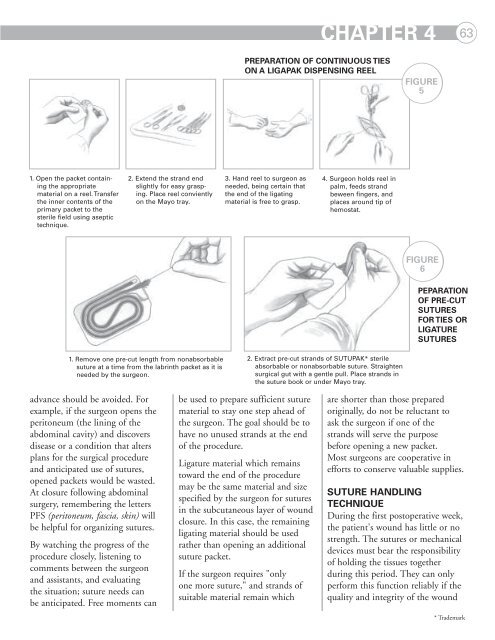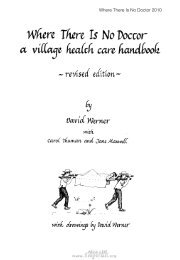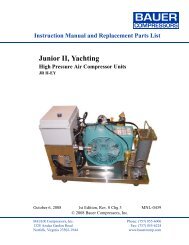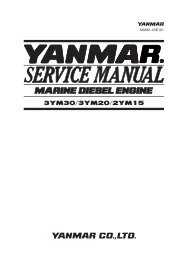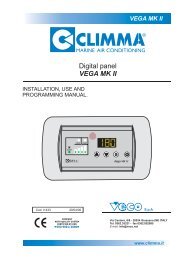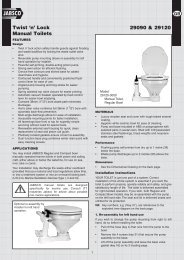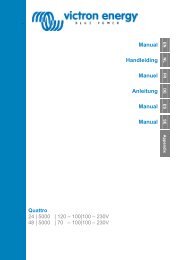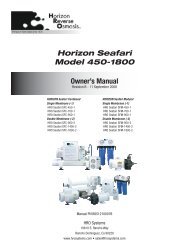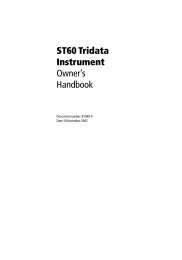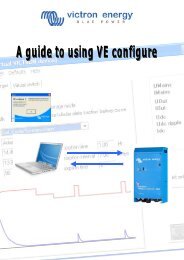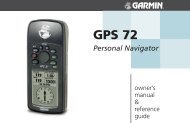Wound Closure Manual (PDF) - Penn Medicine
Wound Closure Manual (PDF) - Penn Medicine
Wound Closure Manual (PDF) - Penn Medicine
Create successful ePaper yourself
Turn your PDF publications into a flip-book with our unique Google optimized e-Paper software.
CHAPTER 4 63<br />
PREPARATION OF CONTINUOUS TIES<br />
ON A LIGAPAK DISPENSING REEL<br />
FIGURE<br />
5<br />
1. Open the packet containing<br />
the appropriate<br />
material on a reel. Transfer<br />
the inner contents of the<br />
primary packet to the<br />
sterile field using aseptic<br />
technique.<br />
2. Extend the strand end<br />
slightly for easy grasping.<br />
Place reel conviently<br />
on the Mayo tray.<br />
3. Hand reel to surgeon as<br />
needed, being certain that<br />
the end of the ligating<br />
material is free to grasp.<br />
4. Surgeon holds reel in<br />
palm, feeds strand<br />
beween fingers, and<br />
places around tip of<br />
hemostat.<br />
FIGURE<br />
6<br />
PEPARATION<br />
OF PRE-CUT<br />
SUTURES<br />
FOR TIES OR<br />
LIGATURE<br />
SUTURES<br />
1. Remove one pre-cut length from nonabsorbable<br />
suture at a time from the labrinth packet as it is<br />
needed by the surgeon.<br />
2. Extract pre-cut strands of SUTUPAK* sterile<br />
absorbable or nonabsorbable suture. Straighten<br />
surgical gut with a gentle pull. Place strands in<br />
the suture book or under Mayo tray.<br />
advance should be avoided. For<br />
example, if the surgeon opens the<br />
peritoneum (the lining of the<br />
abdominal cavity) and discovers<br />
disease or a condition that alters<br />
plans for the surgical procedure<br />
and anticipated use of sutures,<br />
opened packets would be wasted.<br />
At closure following abdominal<br />
surgery, remembering the letters<br />
PFS (peritoneum, fascia, skin) will<br />
be helpful for organizing sutures.<br />
By watching the progress of the<br />
procedure closely, listening to<br />
comments between the surgeon<br />
and assistants, and evaluating<br />
the situation; suture needs can<br />
be anticipated. Free moments can<br />
be used to prepare sufficient suture<br />
material to stay one step ahead of<br />
the surgeon. The goal should be to<br />
have no unused strands at the end<br />
of the procedure.<br />
Ligature material which remains<br />
toward the end of the procedure<br />
may be the same material and size<br />
specified by the surgeon for sutures<br />
in the subcutaneous layer of wound<br />
closure. In this case, the remaining<br />
ligating material should be used<br />
rather than opening an additional<br />
suture packet.<br />
If the surgeon requires "only<br />
one more suture," and strands of<br />
suitable material remain which<br />
are shorter than those prepared<br />
originally, do not be reluctant to<br />
ask the surgeon if one of the<br />
strands will serve the purpose<br />
before opening a new packet.<br />
Most surgeons are cooperative in<br />
efforts to conserve valuable supplies.<br />
SUTURE HANDLING<br />
TECHNIQUE<br />
During the first postoperative week,<br />
the patient's wound has little or no<br />
strength. The sutures or mechanical<br />
devices must bear the responsibility<br />
of holding the tissues together<br />
during this period. They can only<br />
perform this function reliably if the<br />
quality and integrity of the wound<br />
* Trademark


